Some time at the beginning of the year, Saša Marinković, an ornithologist and a friend of mine, called me up and invited me to go with the Birds of Prey Protection Foundation (http://vulture.org.rs/) to Greece and Bulgaria during a long weekend around 1 May (4 days). He said that it was usually their colleagues from Greece and Bulgaria who came to Serbia when some serious, scientific bird-watching took place, but now it was our turn to go there and visit them. Right away I said – yes.
Obviously, I have no serious connection with birds, I am a translator/interpreter who loves to travel, but over time and thanks to different circumstances that I have occasionally mentioned in my travel stories, some windows have opened up in my mind and they concern birds, so now wherever I go, I stare at treetops and the sky. Admittedly, still just along the way. Sometimes I even get lucky and see an interesting bird and even take a photo of it, and this is something that can be seen in my travelogues.
But, this was an invite for a very interesting, specific, in a way very exclusive and quite non-standard trip, and thus this was not an offer to be refused. Meanwhile, my friend Sonja also said she would go and so everything was as fine as it should be.
Admittedly, as the dates of the trip approached, different other friends asked me where I was going and what the plan was, and I would say that I had no clue. And indeed this was the case. That’s what I call “having faith in life.”
Still, less than a week before the departure I finally looked up where we were to spend the nights and was quite content with this. Here is the map of the places we eventually visited during the trip:
And as for the beginning, we left early in the morning – already at 6 o’clock. The journey was very long – in the end it took us 14 hours to get to the day’s destination, but... The coach was very comfortable and there were fewer passengers than seats, so Sonja and I could take two seats each. On the other hand, the journey also included several coffee breaks, as well as the crossing of two international borders.
Since our final destination for the day was the city of Alexandroupoli in the far east of Greece, we travelled via Bulgaria. I had been in Bulgaria a couple of times, both times during weekends and with my hiking club, but that was a long time ago. I remember that the nature was majestic and the people were great. On this day, however, I could only look at Bulgaria through the window, not counting a break we made at a road inn, and I was as impressed by the beautiful nature as before.
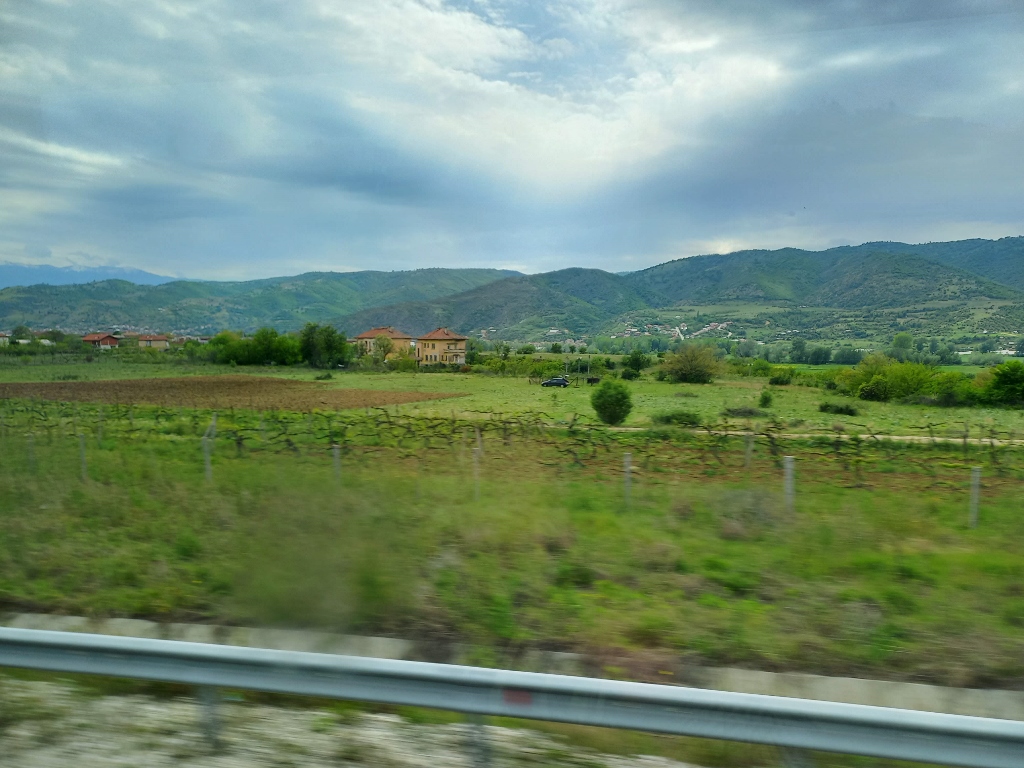 Landscapes by the road leading through Bulgaria
Landscapes by the road leading through Bulgaria
When we later reached Greece, I had better concentration and remembered to take photos around the restaurant where we made a break. There was a small chapel, some kind of a mini-zoo with deer, a peacock and chicken, but the surrounding nature was also very pretty, while the vineyards were getting ready for the new season.
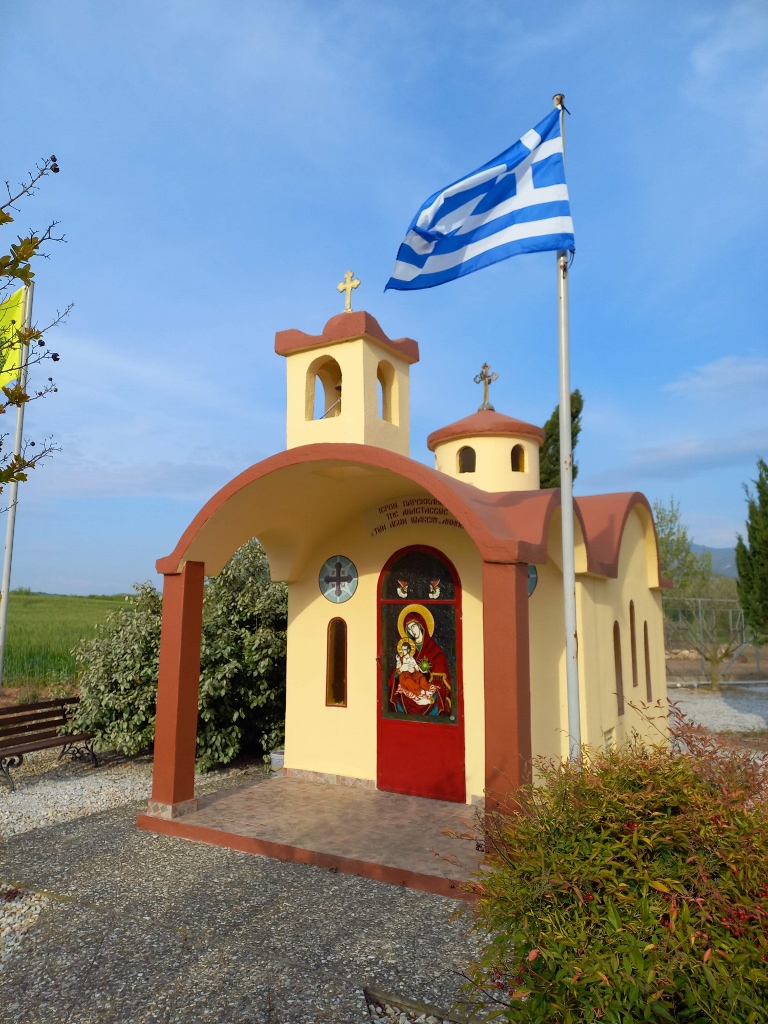 We have arrived in Greece
We have arrived in Greece
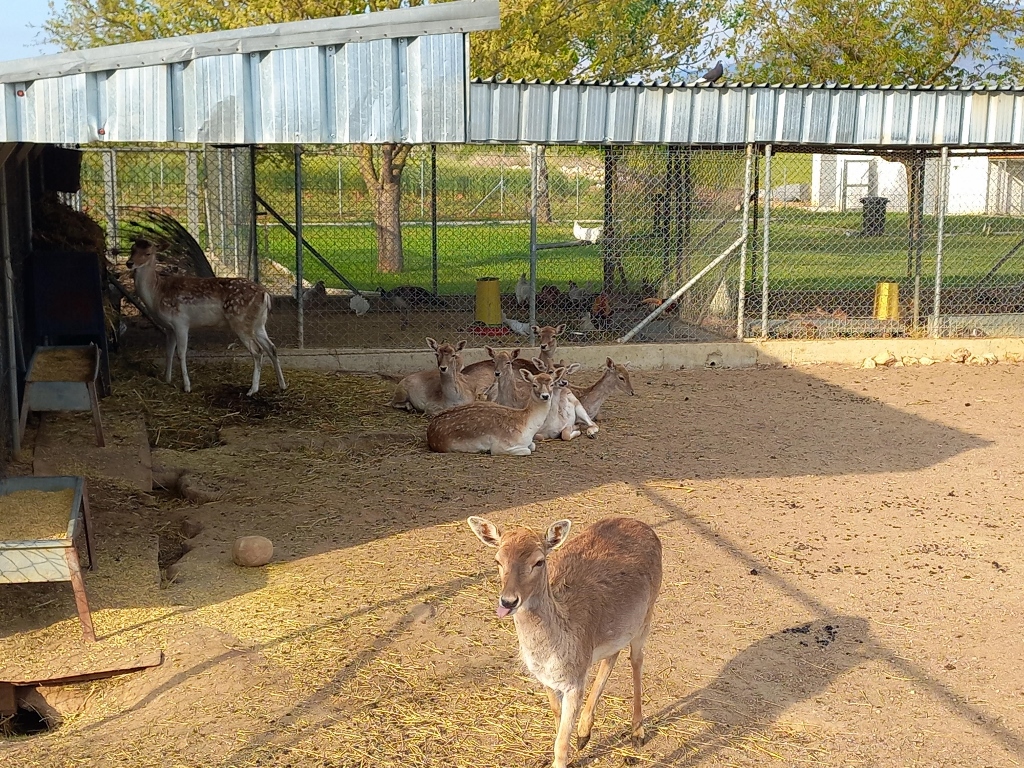 Mini-zoo with the deer in the foreground
Mini-zoo with the deer in the foreground
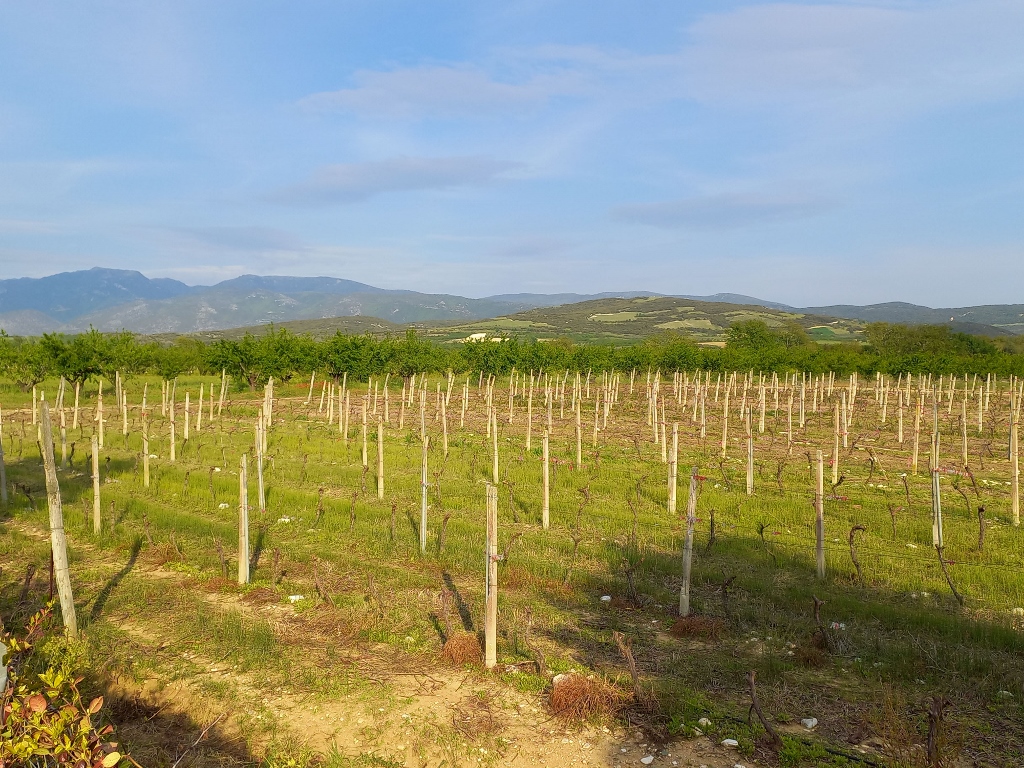 Landscapes in northern Greece
Landscapes in northern Greece
By the way, there are several archaeological sites in this part of Greece, but these were neither our destination nor the theme of the journey, so we just moved on and soon we reached the coast of the Aegean Sea. There we continued further to the east and from time to time I could see the island of Thasos from the road.
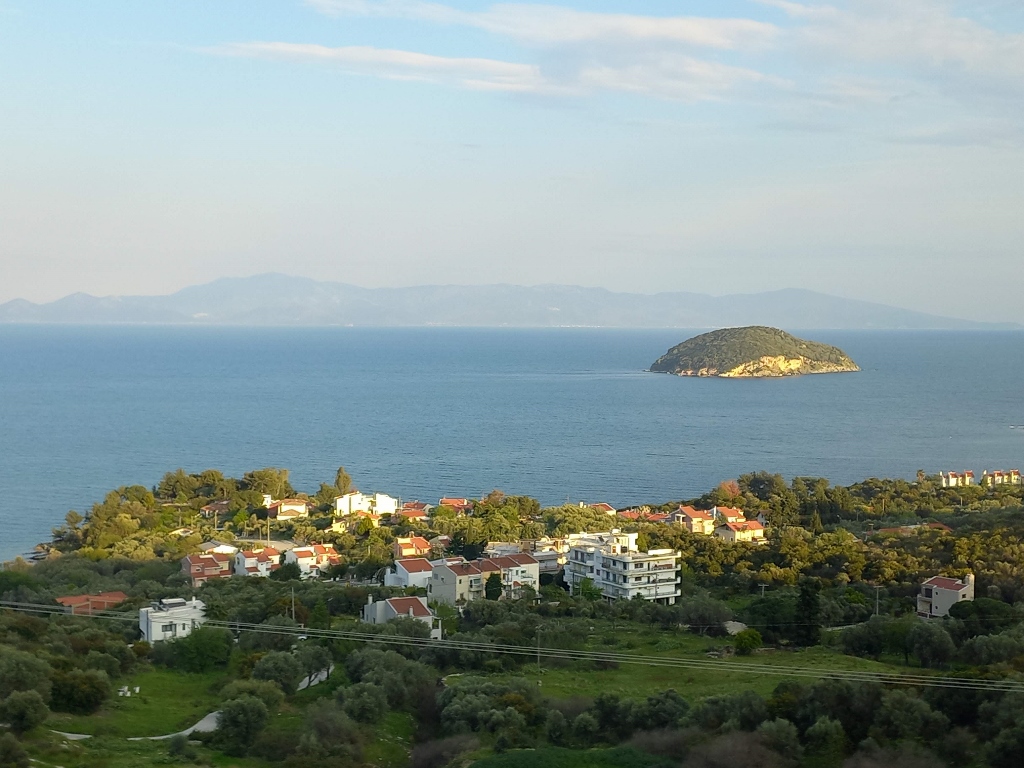 Aegean Sea and the silhouette of the island of Thasos on the horizon
Aegean Sea and the silhouette of the island of Thasos on the horizon
When we arrived in Alexandroupoli in the evening and got our rooms, some members of the group went to a nearby restaurant for dinner, but I decided not to go anywhere, opting rather to go to bed instead. And yet, this was not a reason to miss out on a beer at the hotel bar and the “celebration” of my new stay in Greece – there was a tradition to uphold and this, among other things, entailed one of the local beers.
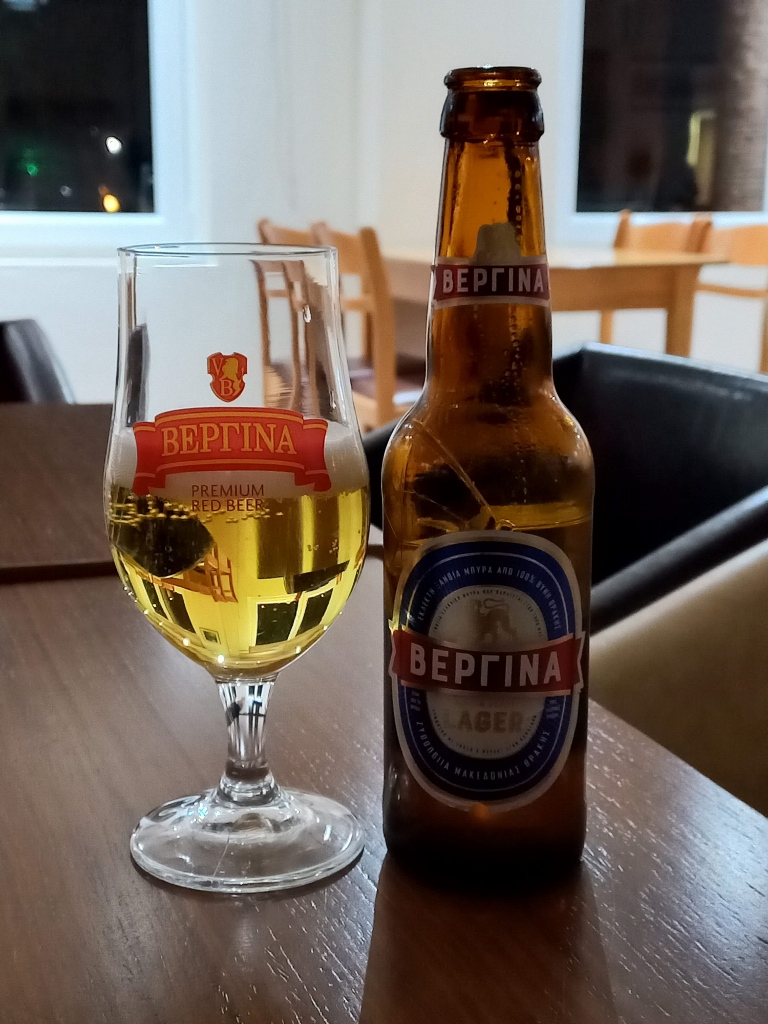 Greek beer
Greek beer
The following day, comparatively early, we all got up and after breakfast transferred to the Dadia-Lefkimi-Soufli Forest National Park that is some 70 km away from Alexandroupoli. This is an area in the far east of Greece, practically alongside the border with Turkey, and it covers a surface area of 428 sq. km. The NP was founded in 1980 and it is rich in both flora and fauna. Some 60-65 species of mammals have been registered at the park, over 200 bird species (36 diurnal birds of prey out of 39 species that inhabit Europe), 29 reptile species and 13 amphibian species, as well as over 360 plant species. Because of such natural qualities of this part of Greece and the biological features, the National Park has been inscribed in the UNESCO’s Tentative List of world cultural and natural heritage. What makes this park particularly interesting for the group of ornithologists and amateur bird-lovers whom I joined on this trip is the fact that the black vulture, the Egyptian vulture and the Eurasian griffon vulture live and breed within the park. In other words, as many as three out of four European vulture species.
So, we came to the Visitor Centre and there we met our hosts, Dimitris Vasilakis and his colleague. While the old friends and colleagues greeted one another, I noticed nearby a beautiful bunch of wild irises – according to what I have managed to dig out, I think this was the bearded iris (Iris reichenbachii).
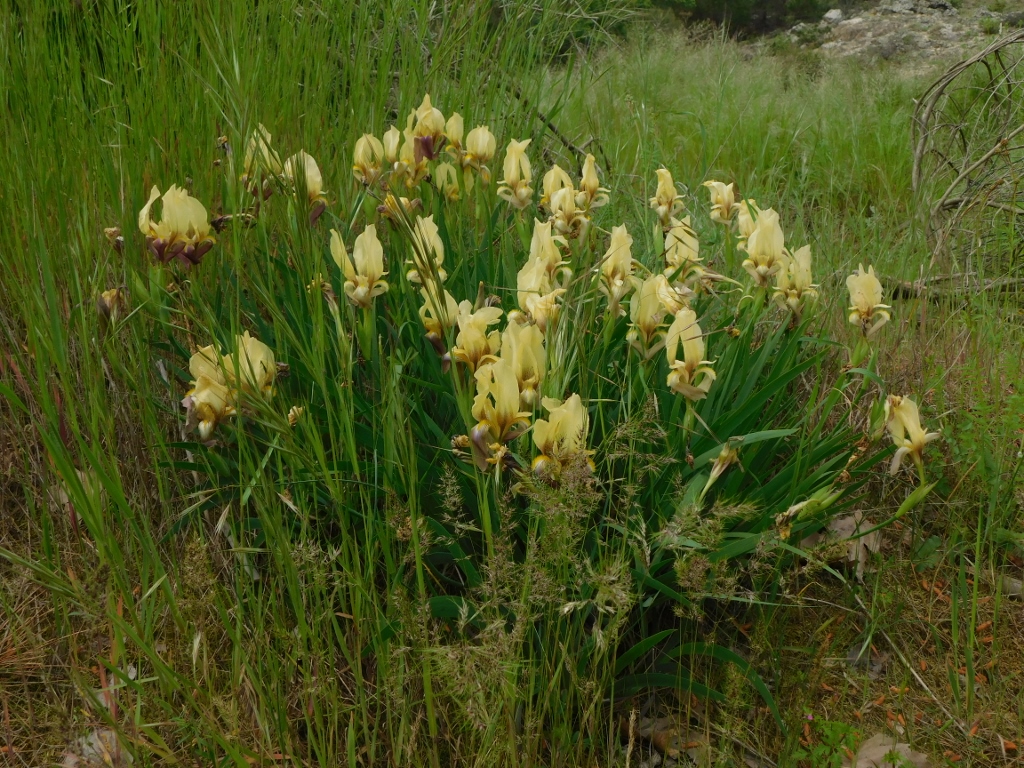 Bearded iris
Bearded iris
Then all the members of the “delegation” were given a T-shirt. Since I go for a trip with the Fund almost regularly, by this time I have a very nice and interesting collection of thematic T-shirts that they produce each year.
This year, the T-shirts had a special symbol on them – the depiction of a two-headed griffon vulture from the coat-of-arms of the Nemanides dynasty from 1208.
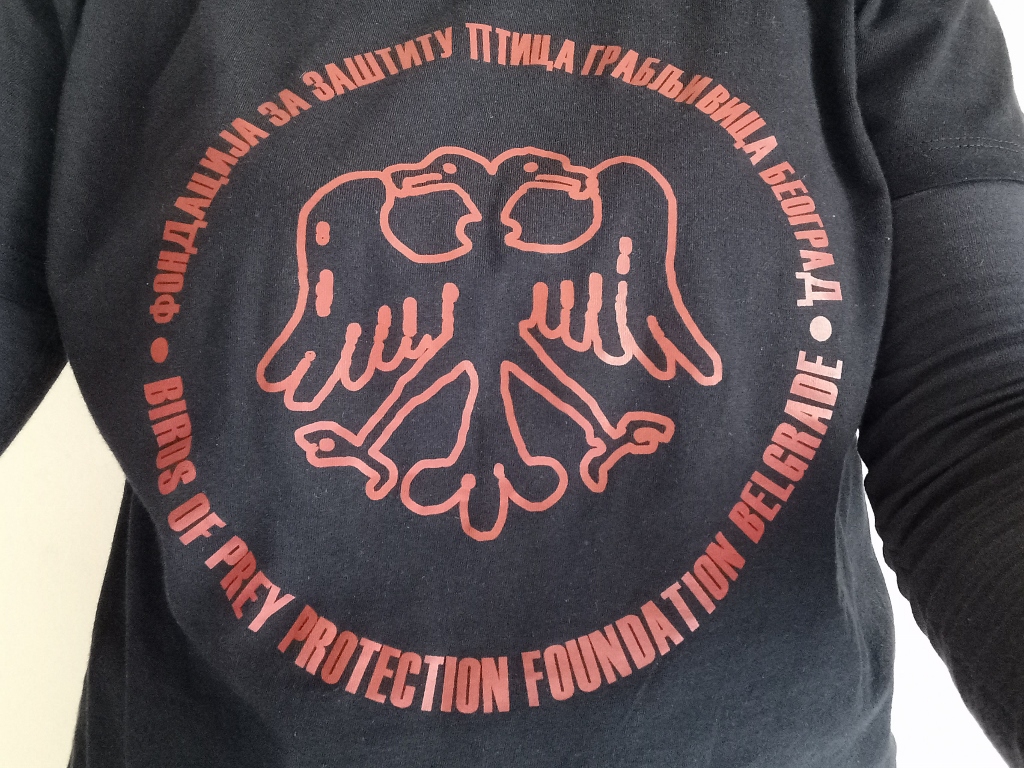 T-shirt from 2023
T-shirt from 2023
I must admit I have no clue about the heraldry and neither am I keen on going any deeper into the subject, so I have to rely on the information I got from the people in the know.
So, the first depiction of a two-headed griffon vulture on the Nemanides coat-of-arms appeared at Žiča Monastery in 1208, not as a part of the frescoes, but rather on an object that is kept at the monastery’s treasury. It was red, since at the time the Serbian Church was still not autocephalous, but this changed later on. This means that the griffon vulture from the coat-of-arms could be painted in white and gold from then on. (For some reason, unclear to me, this was actually very important.) The depictions of a two-headed griffon vulture appeared subsequently at the other Serbian monasteries, while different versions of this coat-of-arms were used by the Lazarević, Mrnjavčević and Crnojević dynasties.
What is important here is that the awareness that it was a two-headed griffon vulture rather than a two-headed eagle that was used in the coat-of-arms of the Serbian traditional dynasty and their direct successors has been lost over time. The two-headed eagle has been used later on and even today it appears as the symbol both in Serbia, as well as among other nations.
The reason for using griffon vulture and not eagle in this becomes much clearer when one notes the very name of the bird - Eurasian griffon vulture - which contains the word “griffon” that was certainly not given by accident.
Griffon is a mythical animal with the eagle beak and wings, and the lion body. In other words, griffon brings together two animals – one is linked to the earth and the earthly strength, while the other is linked to the sky and the celestial energy. In this way, griffon vulture, unlike eagle, is considered an animal that lives between the two worlds – our own, material and human, and the other one, spiritual and divine. Hence the two heads.
But, let me clear something up. The people I was here with and who told me all of this love equally both the griffon vultures and the eagles, so nobody could reproach them for being partial.
Let me just mention that, as far as I understood, the first depiction of a two-headed griffon vulture was used by the Hittites. Significantly later the symbol was used by the Serbs, while the Byzantines started to use it as their imperial emblem even after the Serbs.
But, irrespective of the fact that a two-headed eagle can nowadays be seen in many coats-of-arms, at least this one printed on the T-shirt clearly shows a two-headed griffon vulture and I think this is quite enough.
Let me now go back to the trip to the Dadia-Lefkimi-Soufli Forest National Park that for the sake of simplicity I will continue to refer to as the Dadia Forest. After the greetings and the distribution of T-shirts, we all went for a walk through the forest with the aim to get to a viewpoint from which it is possible to watch the birds.
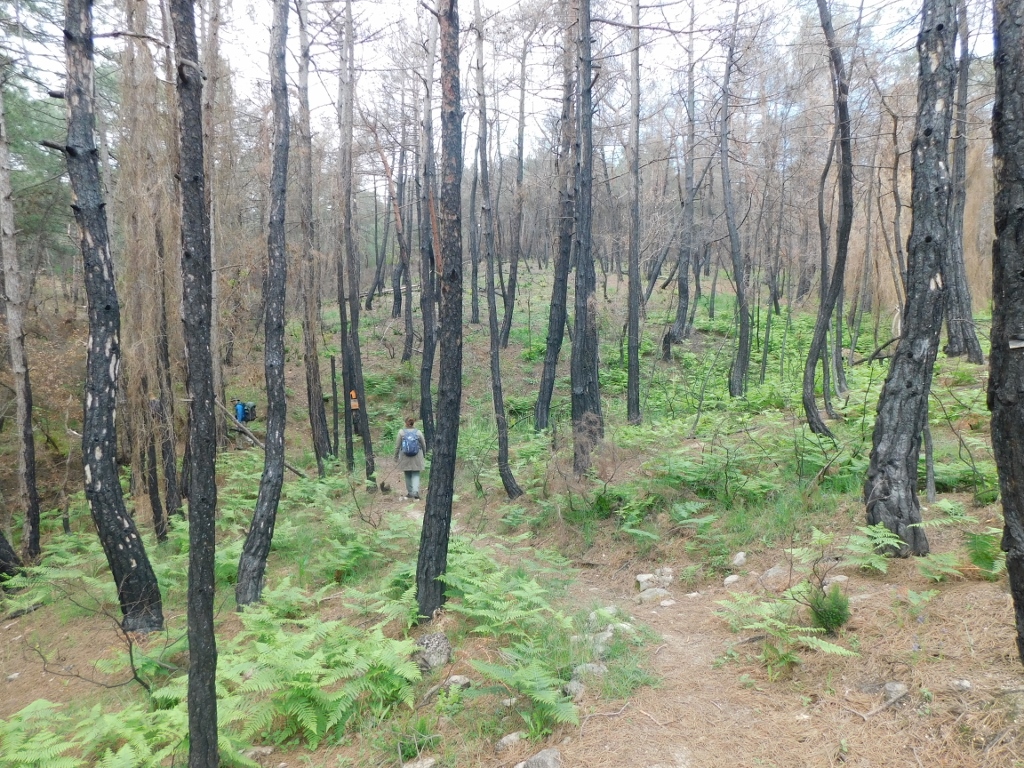 Dadia Forest at the end of April 2023
Dadia Forest at the end of April 2023
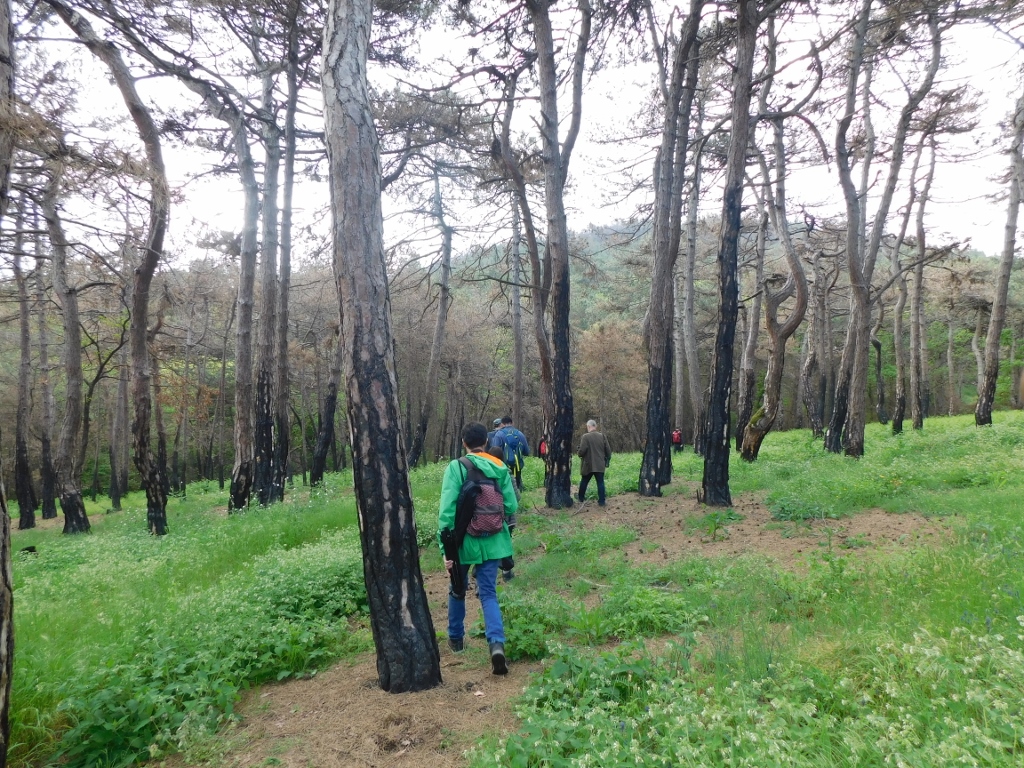 Dadia Forest at the end of April 2023
Dadia Forest at the end of April 2023
In the beginning, the trail led mostly over a comparatively flat terrain, a little bit down and a little bit up, but flattish on an average. As it may be seen from the photos, the trees were oddly black. The reason for this is that there was a major forest fire here in summer 2022 and as much as one third of the forest burned down. Needless to say, there are problems about this now, but listening to your hosts it seemed to me that different aspects of the issue are taken into consideration. Thus, for instance, it is important to ascertain whether all the trees that are black on the outside are in fact dead or not, whether a certain species can re-grow on its own or its requires human intervention in order to assure a balance in terms of the species presence. Let me give an example – a particular problem lies in the fact that there are a lot of black pines growing here, but then cannot restore on their own after a fire and need to be replanted again.
On the other hand, as opposed to the trees, the grasses and flowers seemed not to care in the least about the dramatic events of the previous season. We often passed by individual grape hyacinths (Muscari botryoides) and in one place there was a multitude of these lovely spring flowers.
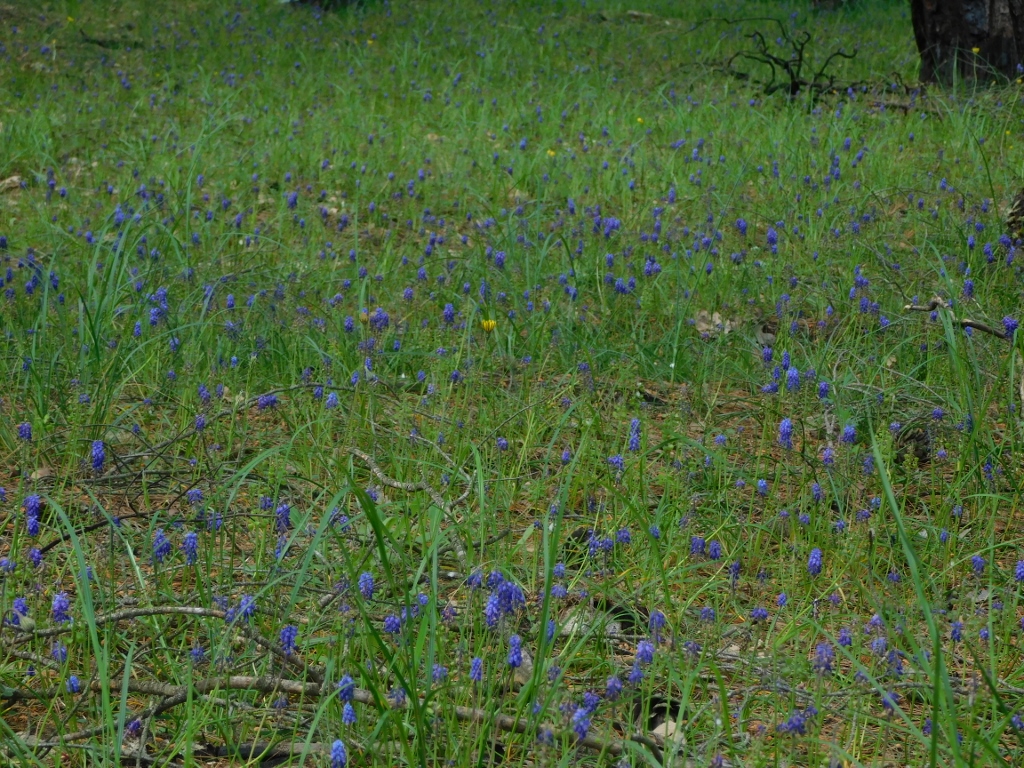 Myriad of grape hyacinths in the Dadia Forest at the end of April 2023
Myriad of grape hyacinths in the Dadia Forest at the end of April 2023
Also, in several places I came across a plant of the Asphodelus genus. Although I find plants rather fascinating, I have realised that differences between species can be minute and thus it is safer in the case of this plant to mention just the genus it belongs to, since I do not know which actual species this was.
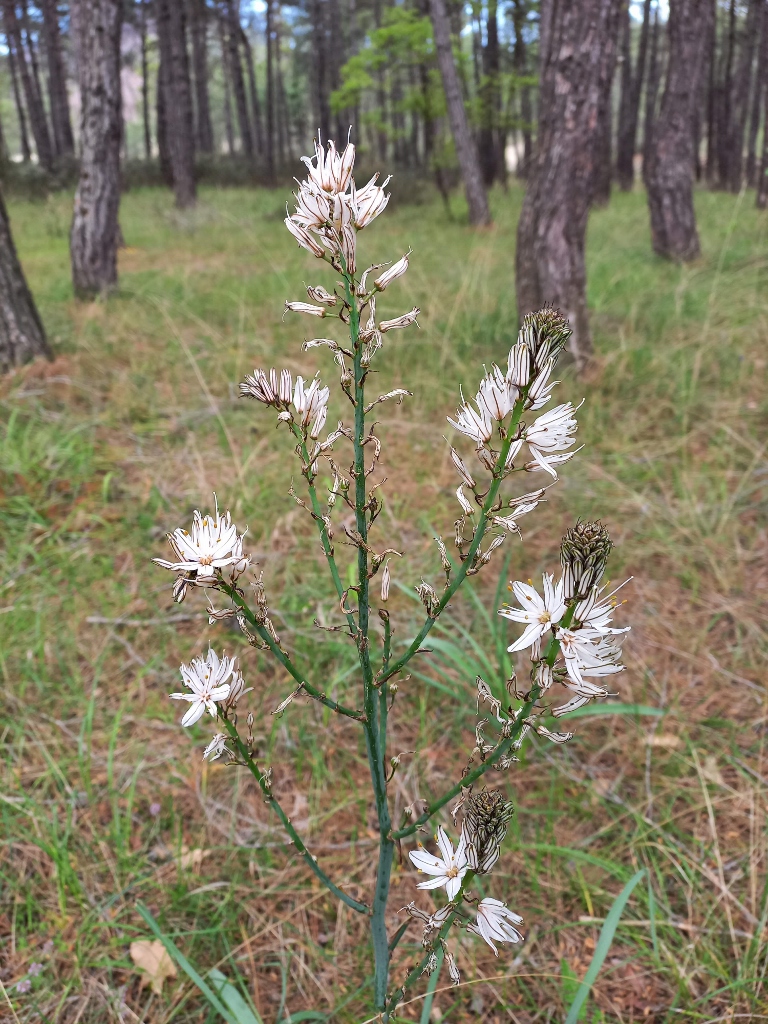 Plant from the Asphodelus genus
Plant from the Asphodelus genus
The walk through the forest felt wonderful and like every time I find myself surrounded by nature I thoroughly enjoyed. On the other hand, some sights, although specifically beautiful in their own way, were certainly a serious reminder of the previous year’s fire.
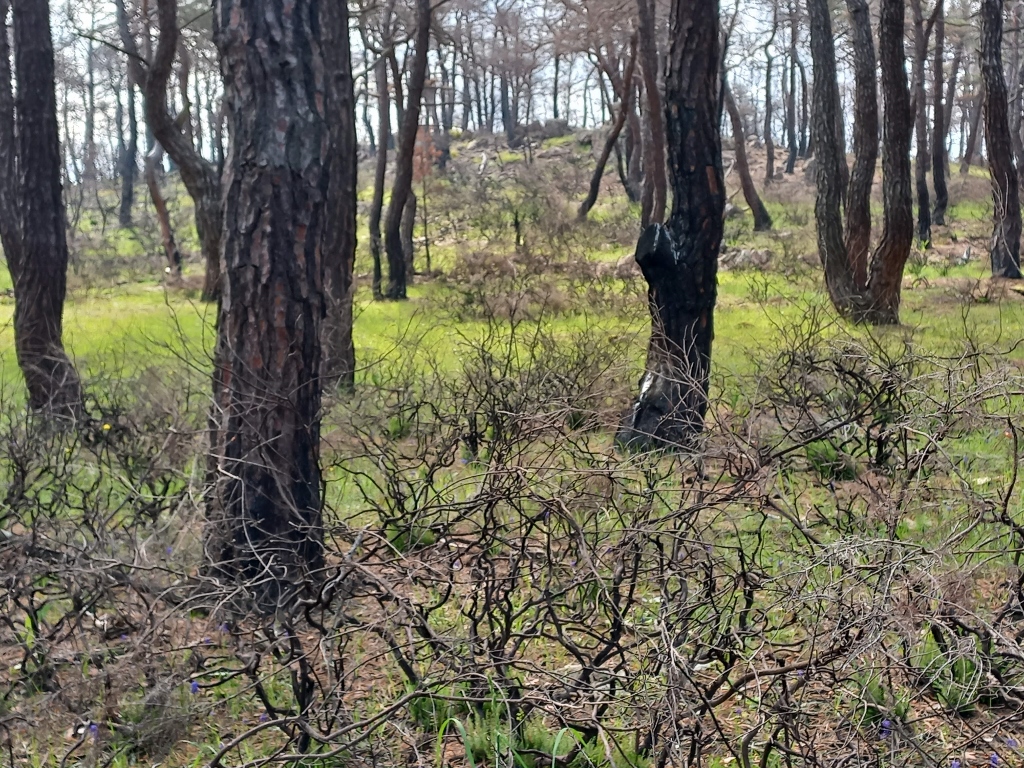 Dadia Forest at the end of April 2023
Dadia Forest at the end of April 2023
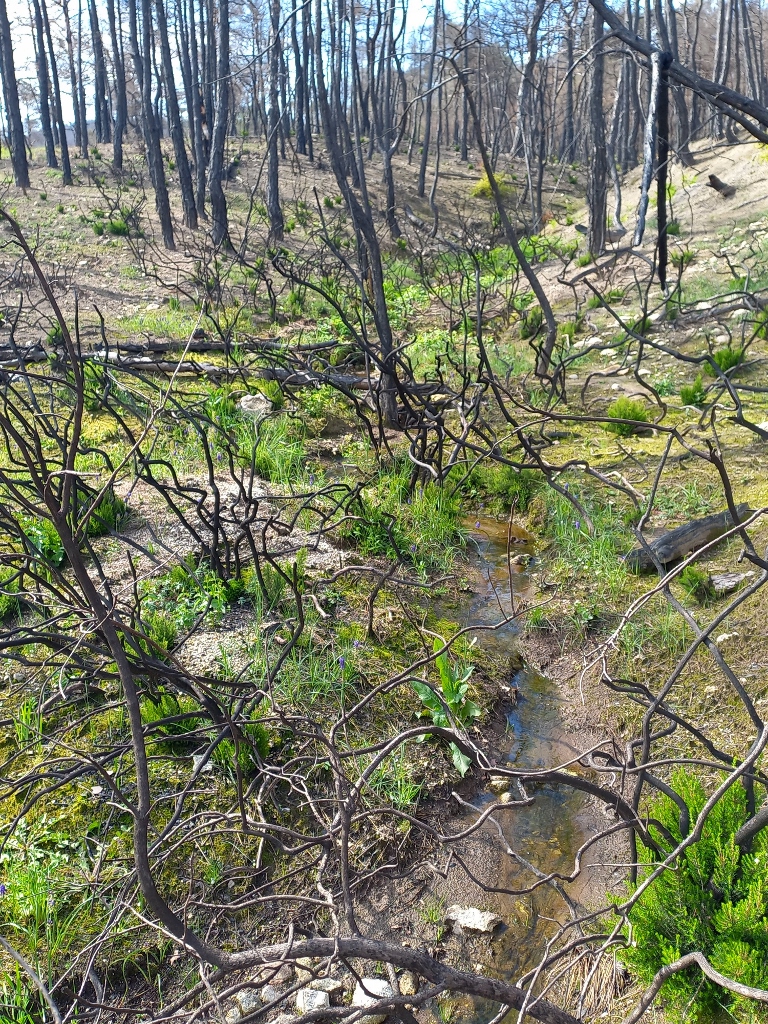 Dadia Forest at the end of April 2023
Dadia Forest at the end of April 2023
In one place I noticed a magical combination of charred remains of a bush, as well as a new plant growing among those thus creating a natural bright green ikebana and showing that life wins. At least here and at least this time.
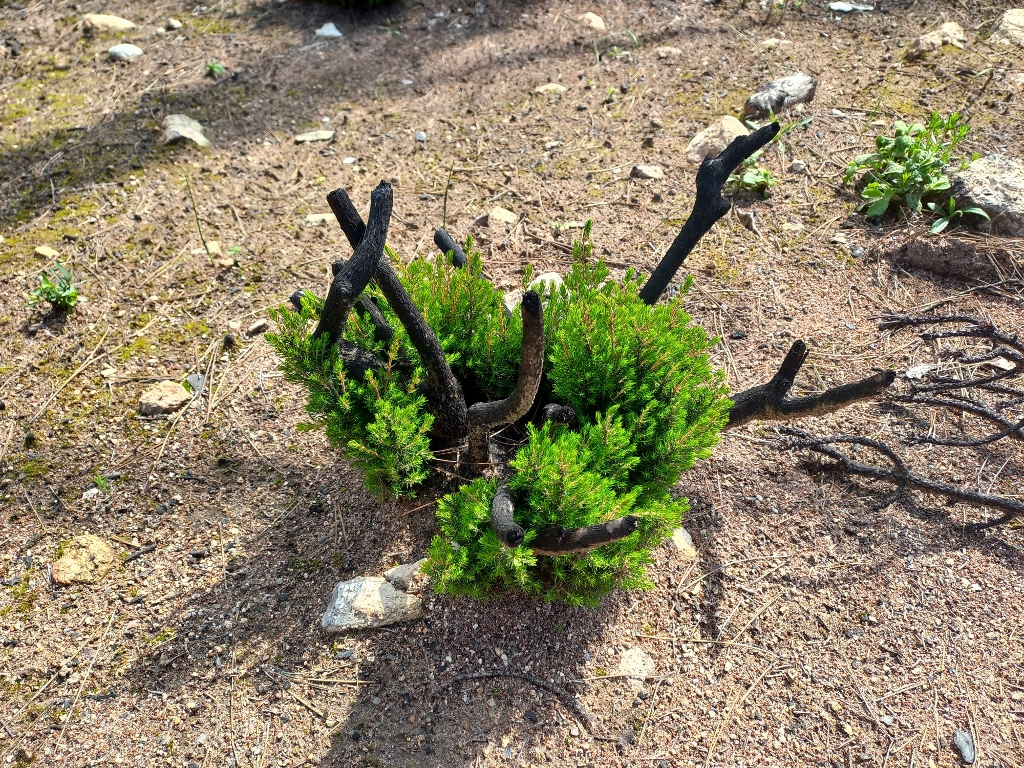 Dadia Forest at the end of April 2023
Dadia Forest at the end of April 2023
The trail that we followed also went along or across a stream and therefore the plants were somewhat different in these parts.
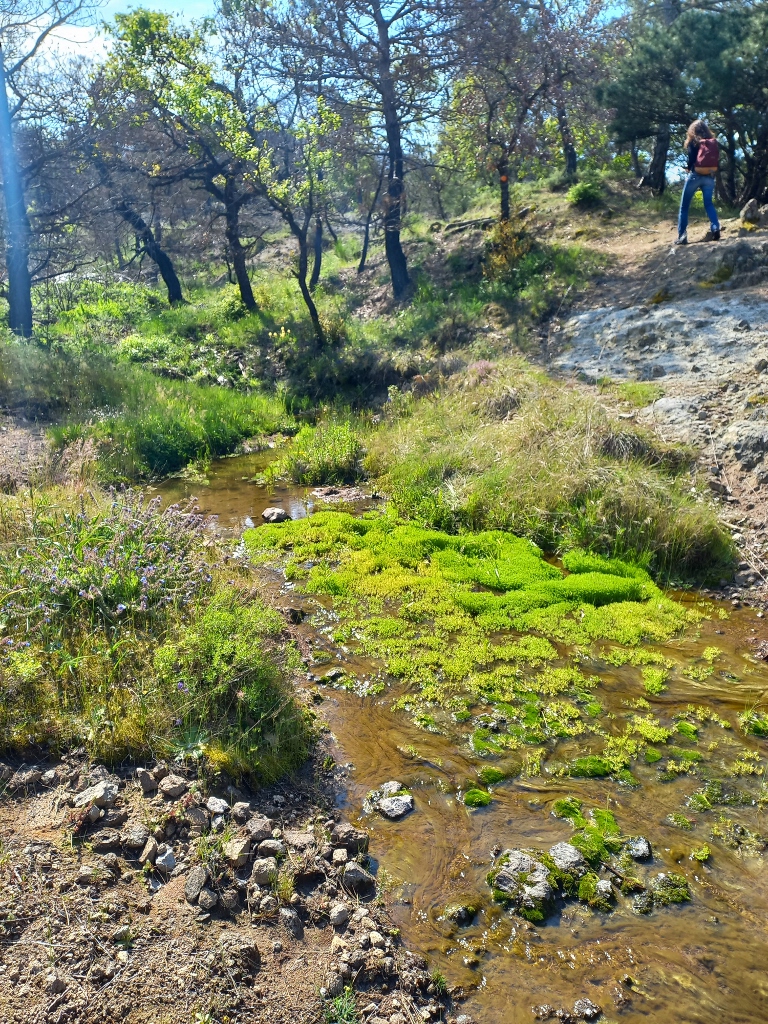 Dadia Forest at the end of April 2023
Dadia Forest at the end of April 2023
As it can be seen in the photo above, at some point the surroundings started to change, there were more rocks and occasionally a little bit less of trees. Still, all the sights were stunning and this was particularly helped by the fact that the clouds had started to disperse and there was more sunlight, which always brings certain joy.
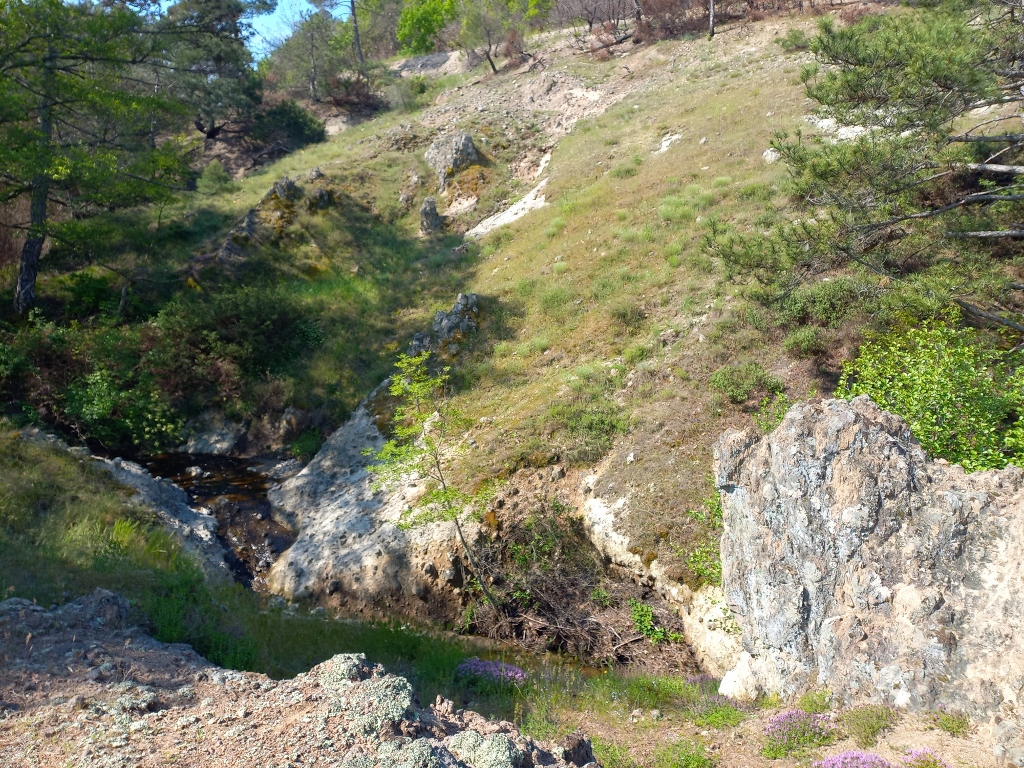 Dadia Forest at the end of April 2023
Dadia Forest at the end of April 2023
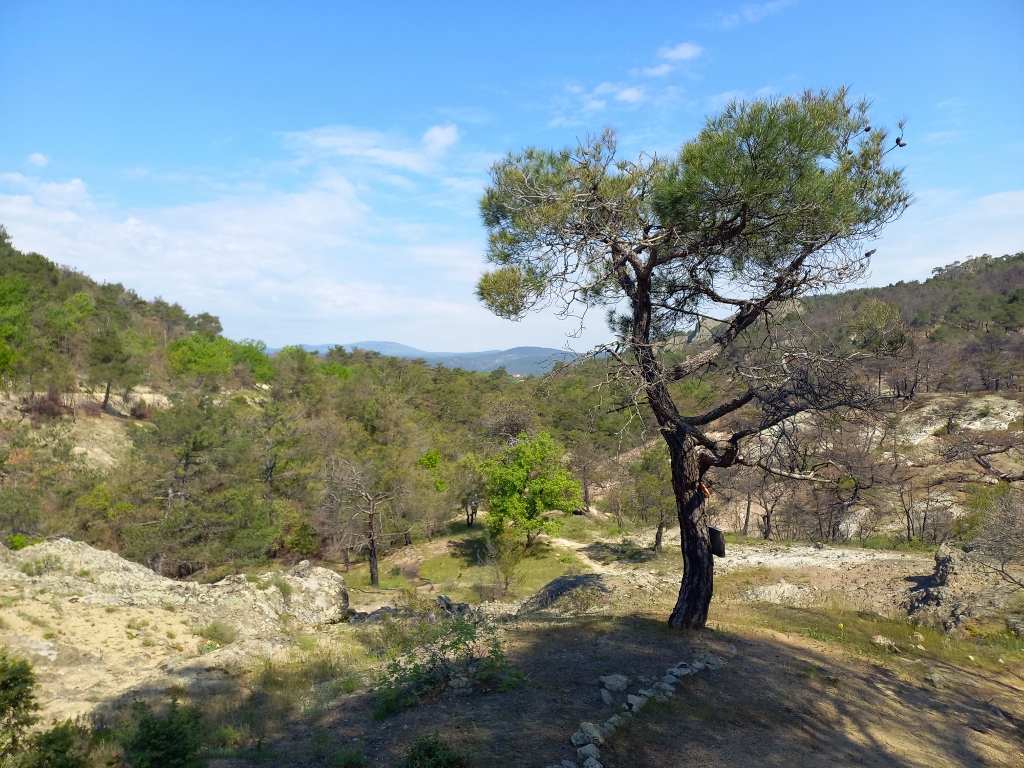 Dadia Forest at the end of April 2023
Dadia Forest at the end of April 2023
Certainly, the low vegetation also changed and so at one point the trail led beside opulent and wonderful clusters of wild thyme (Thymus serpyllum).
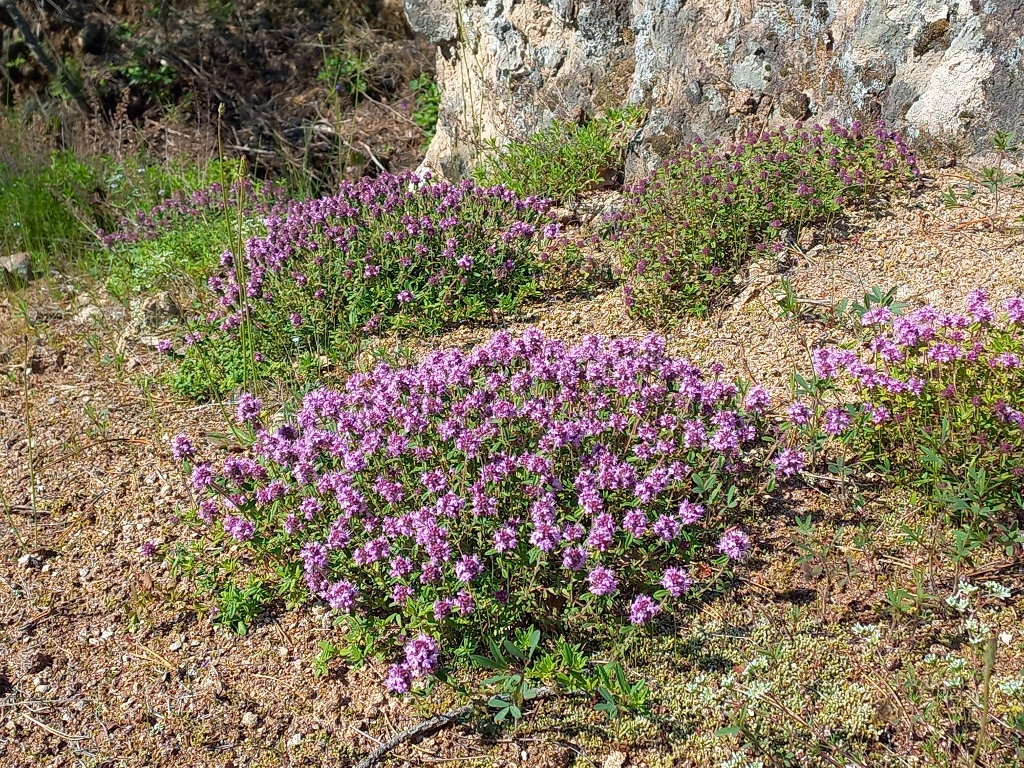 Wild thyme
Wild thyme
In addition to yellow bearded irises that I occasionally walked by, I also encountered a couple of specimens of purple colour. I cannot claim, but I think that this is the same species because, according to what I have read, Iris reichenbachii may appear both in yellow and purple variants.
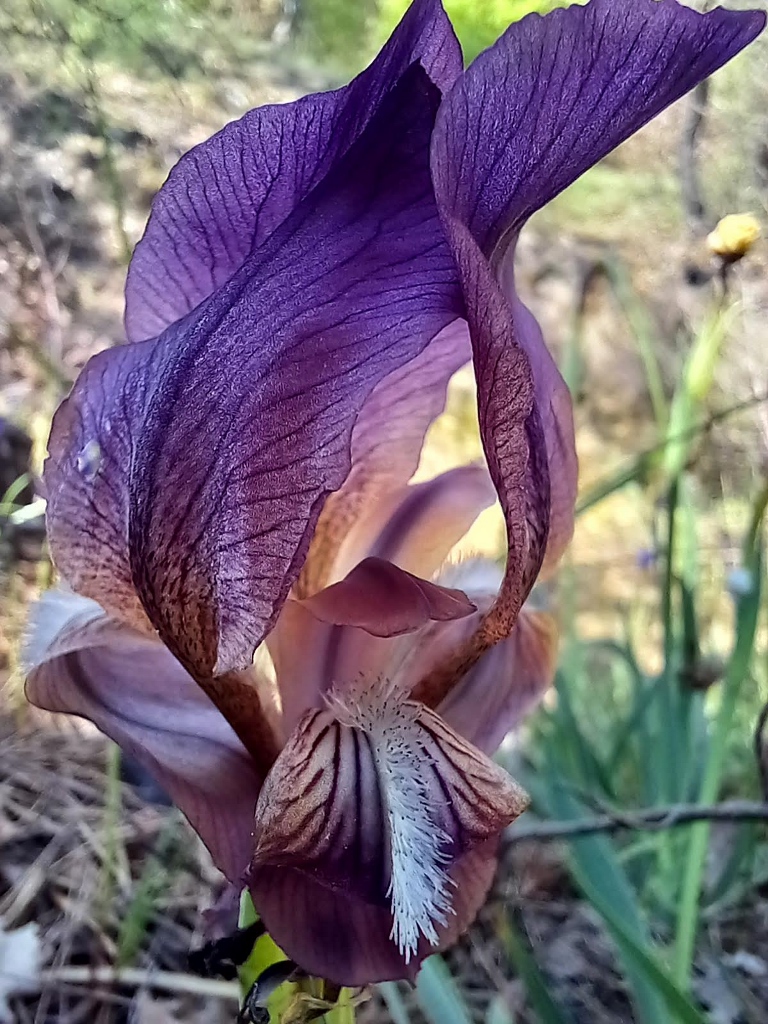 Bearded iris
Bearded iris
And what about the birds?, you may ask. Well, the birds were certainly present all the time, they could be heard quite distinctly, but these were mostly some tiny specimens that were rather restless and kept on moving. Still, as some point I was very lucky and so not only did I see, but I also managed to take a photo of an eastern subalpine warbler (Sylvia cantillans).
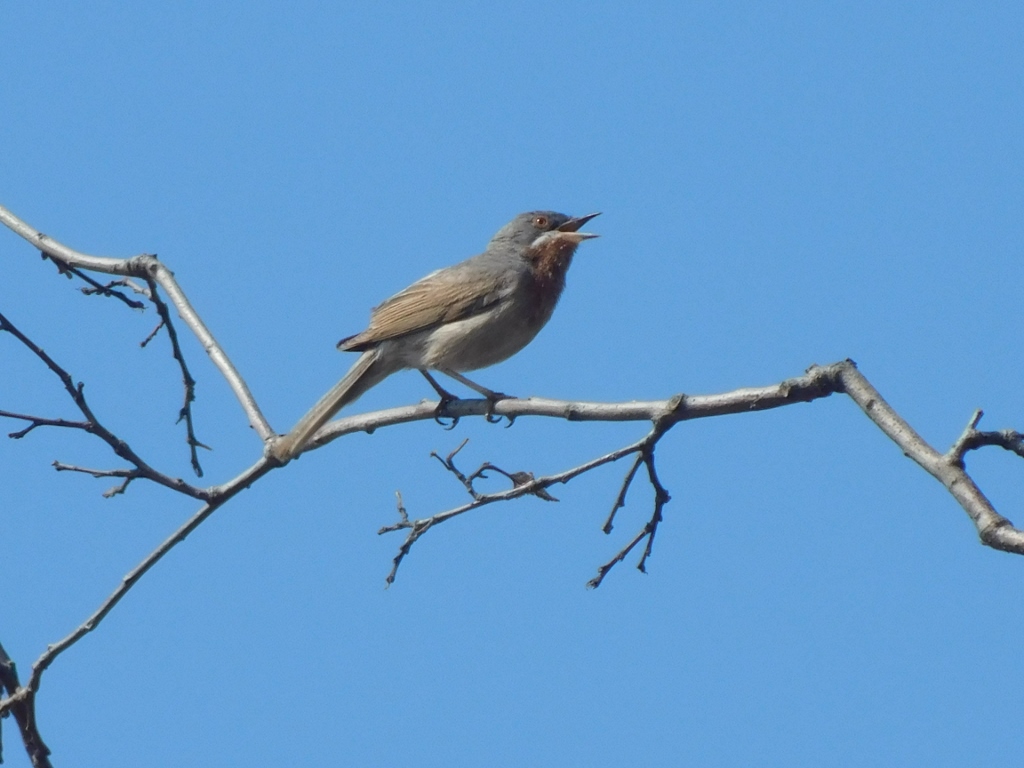 Eastern subalpine warbler
Eastern subalpine warbler
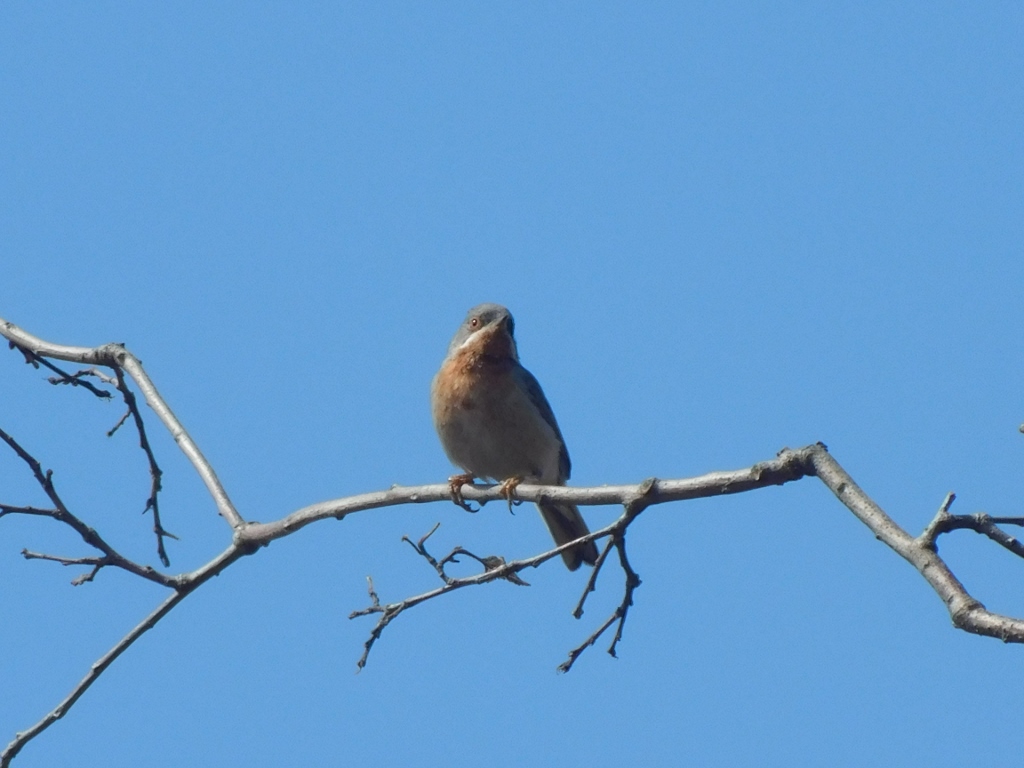 Eastern subalpine warbler
Eastern subalpine warbler
One of my “old” acquaintances from the trips linked to bird-watching, Ljilja, was fully prepared for this trip and so at some point, when we came across a bench, she got out a vacuum flask with coffee. Such a break was more than welcome.
After that, a couple of us that had the coffee break walked over a wooden “bridge” and went along the final section of the trail to the top used for bird-watching.
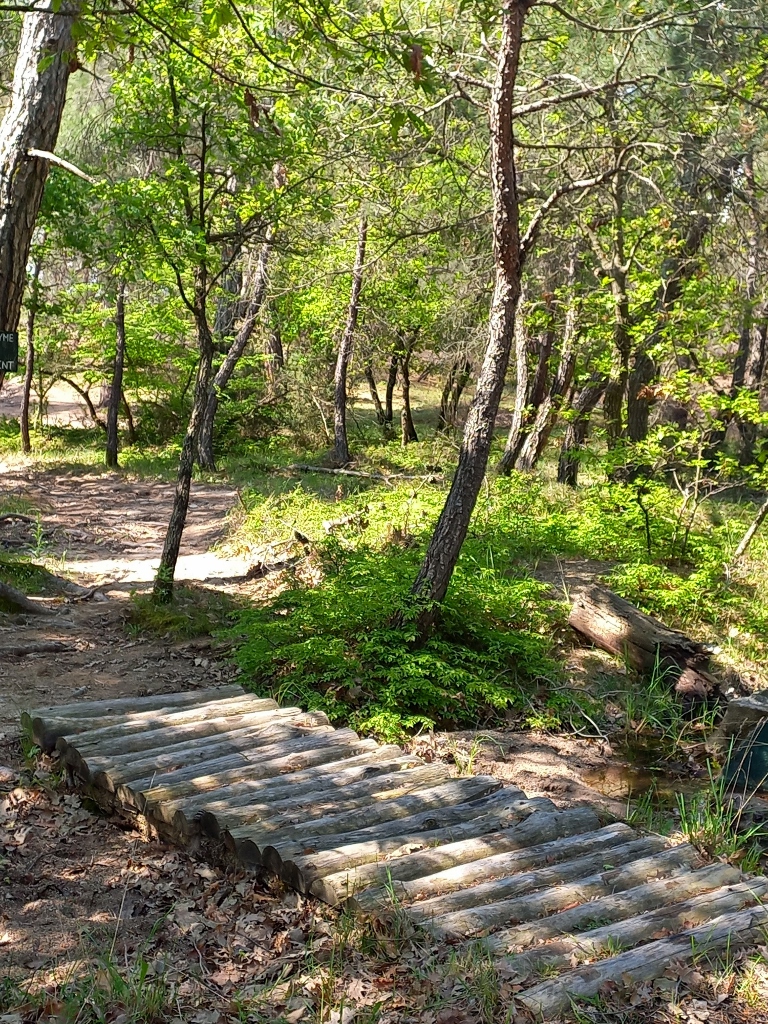 Dadia Forest at the end of April 2023
Dadia Forest at the end of April 2023
By the way, while walking through the forest going to the viewpoint from which we were to look at the birds, we could hear chainsaws, which was a little strange for we were in a national park after all. Later we could see for ourselves that the trees from the elevation used for bird-watching had been cut on a massive scale. As a young man from the group explained to me and he was told by our hosts, the people from the national park leave the burned pines for a while and they monitor their state. If the pines shoot out new leaves next spring, it means that the tree has actually survived the fire and there is still life inside of it.
But, if no signs of life appear on a tree, then the tree is cut down because after a second year it would lose on its quality and could not be used at least as timber. Since there was (biological) damage anyway, it would be a pity to waste whatever is left there.
 Area around the bird-watching viewpoint in Dadia Forest at the end of April 2023
Area around the bird-watching viewpoint in Dadia Forest at the end of April 2023
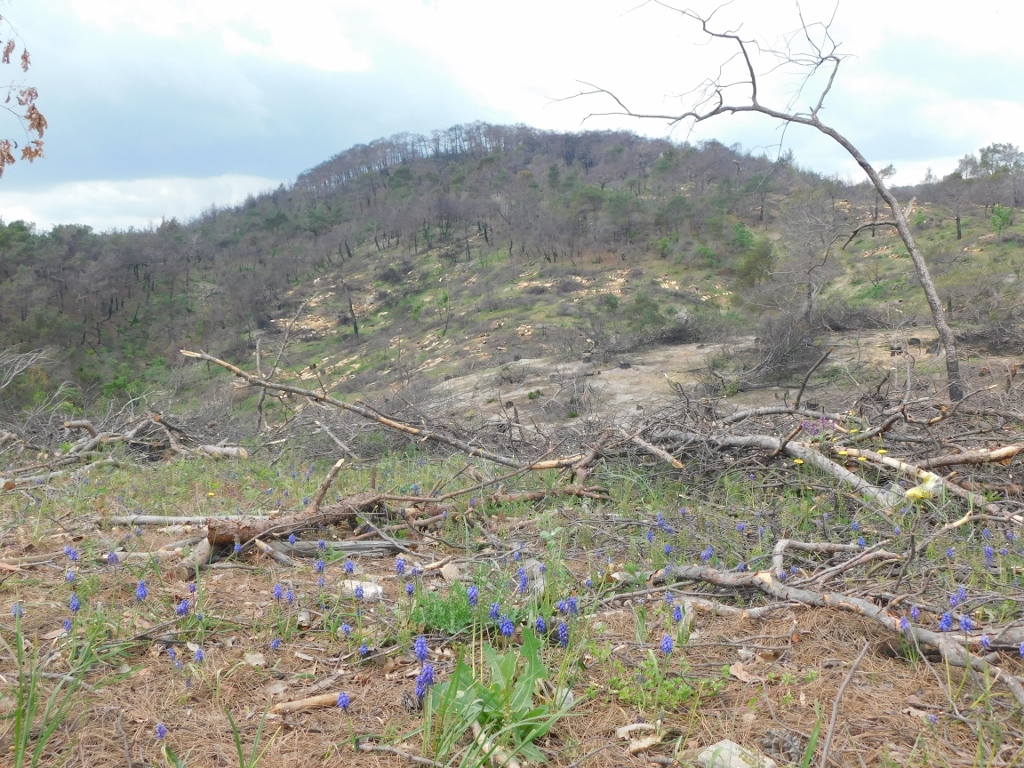 Area around the bird-watching viewpoint in Dadia Forest at the end of April 2023
Area around the bird-watching viewpoint in Dadia Forest at the end of April 2023
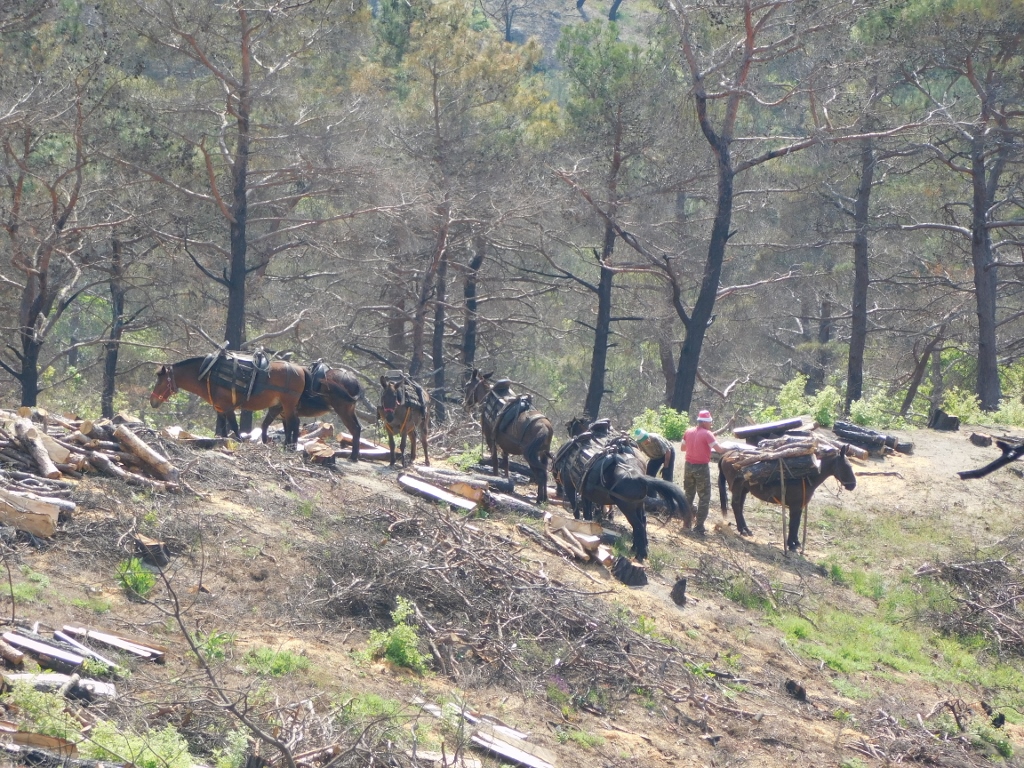 Area around the bird-watching viewpoint in Dadia Forest at the end of April 2023
Area around the bird-watching viewpoint in Dadia Forest at the end of April 2023
But, objectively speaking, the state of the trees did not prevent us from watching the birds. Their feeding ground, that is, their favourite place for gathering is located on the next elevation and, according to what I understood, access to the feeding site is strictly forbidden except for the experts in order not to bother the birds.
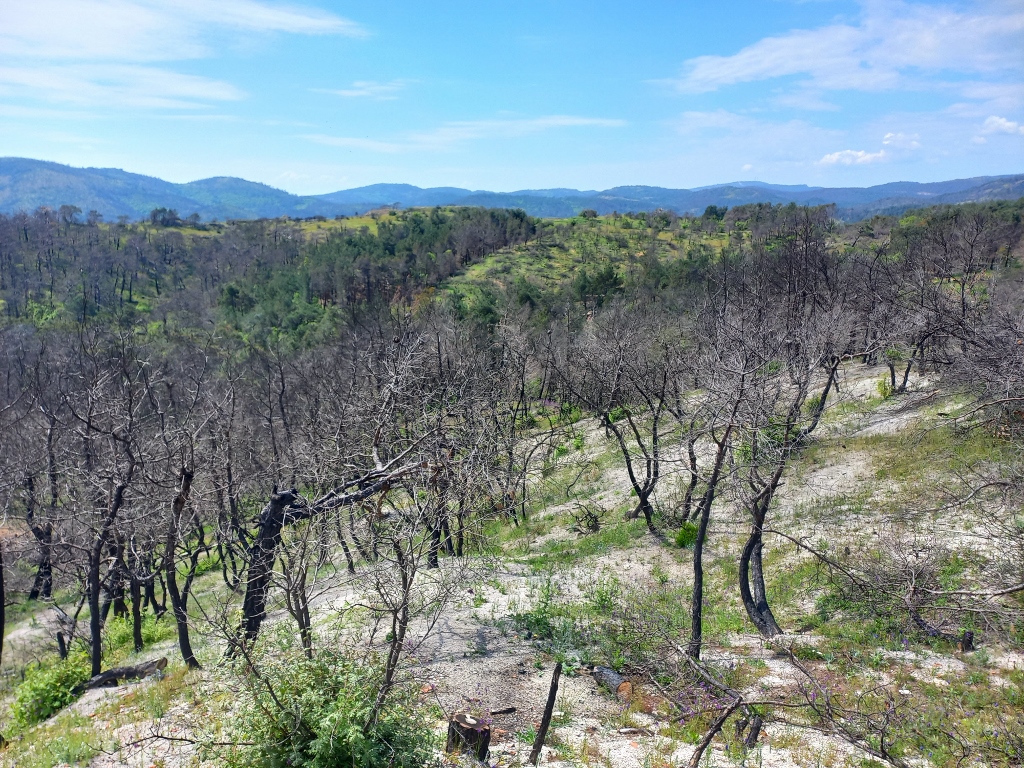 View towards the feeding site for birds in Dadia Forest at the end of April 2023
View towards the feeding site for birds in Dadia Forest at the end of April 2023
With a lot of binoculars among the members of the group, as well as the sharp eyes of different individuals, we could all notice a couple of birds standing at the feeding site. My photo-camera is not of a professional quality for taking shots of birds at large distances, but I did manage to get a reasonably acceptable photo of a cinereous or (Eurasian) black vulture (Aegypius monachus) that was standing on the top of the green elevation seen in the photo below. In the end it was not too bad, I guess.
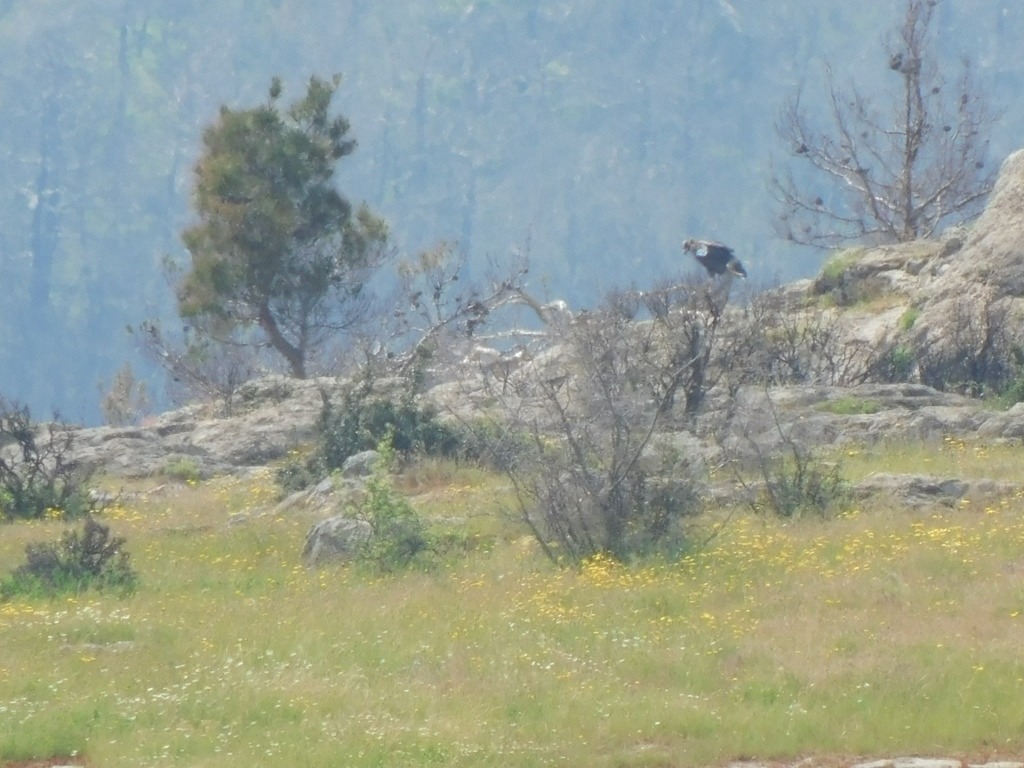 Cinereous or black vulture in Dadia Forest
Cinereous or black vulture in Dadia Forest
The cinereous or black vulture is the biggest bird of prey in Europe. Its length can go up to 1.2 m, the wingspan up to 3.1 m, while its maximum weight can be as much as 14 kg which makes it one of the heaviest flying birds. It was thanks to the fact that this is a big bird that I succeeded at all in taking a photo of it at such a large distance.
But, there were also birds much more closely – in the sky, where they were flying almost above us. This time I managed to get a photo of a black kite (Milvus migrans) that is also a bird of prey, but on an average half the size of a black vulture and significantly lighter – its weight can be up to around 1 kg.
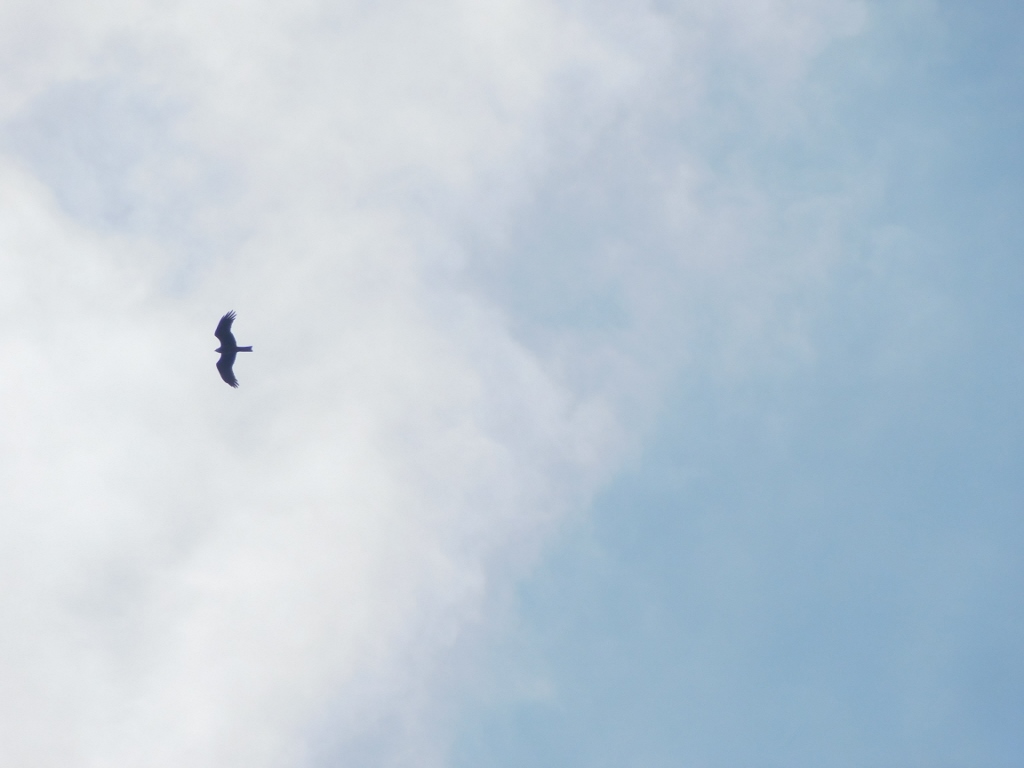 Black kite in Dadia Forest
Black kite in Dadia Forest
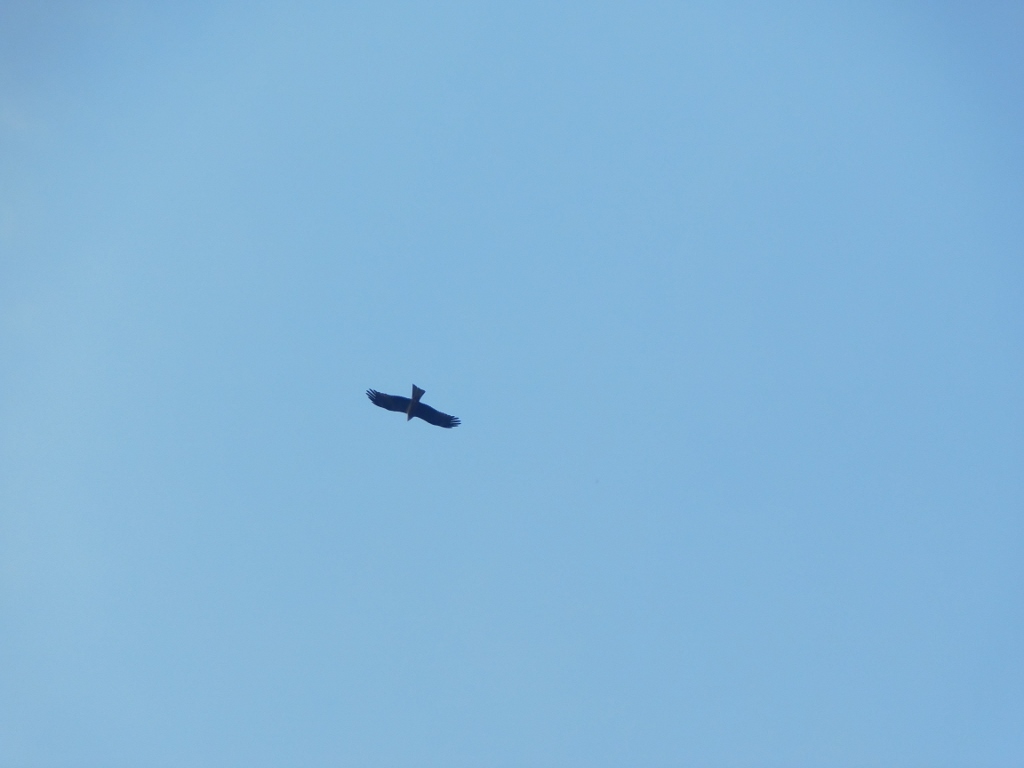 Black kite in Dadia Forest
Black kite in Dadia Forest
After some time spent at the viewpoint, we started to head back. As we were passing by a small pond, Dimitris wanted to show us an amphibian, but instead we saw a small snake. Although it slithered away comparatively fast as a couple of us approached the pond, I took a photo of it. Still, I have no idea which species this was. My hands are already full with identifying birds and so I have no intention to deal with reptiles as well.
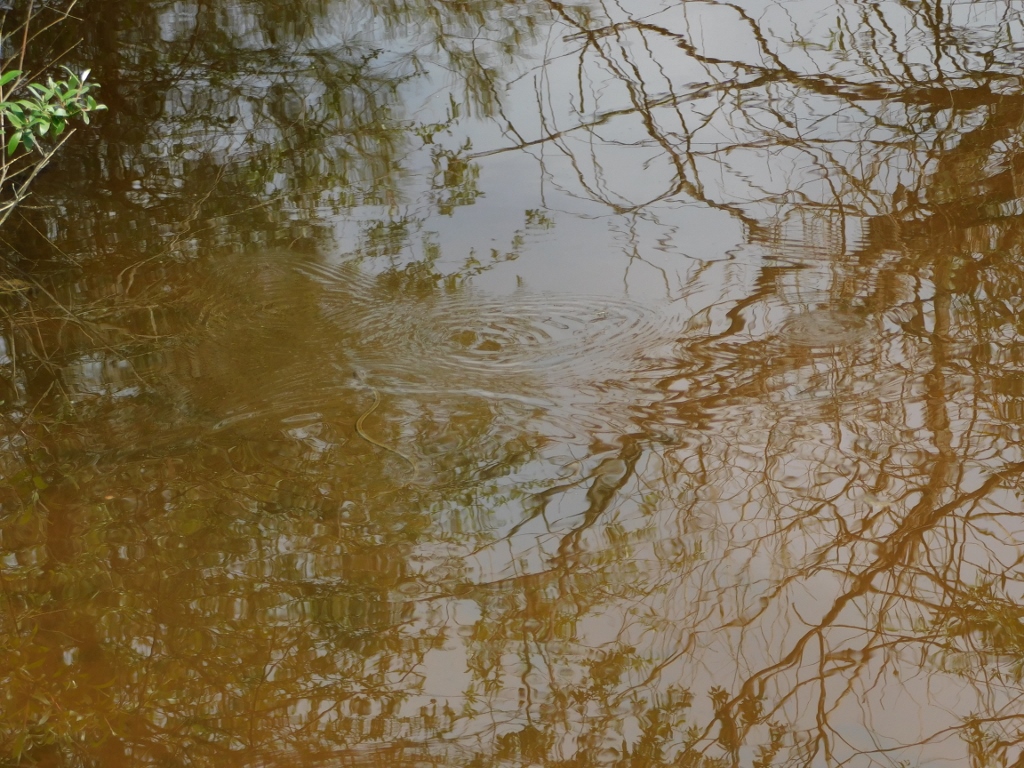 A snake swimming through a pond in Dadia Forest
A snake swimming through a pond in Dadia Forest
As it could be concluded from some of the earlier photos, the clouds had mostly dispersed in the meantime and the weather was really nice, so I enjoyed the walk through nature even more.
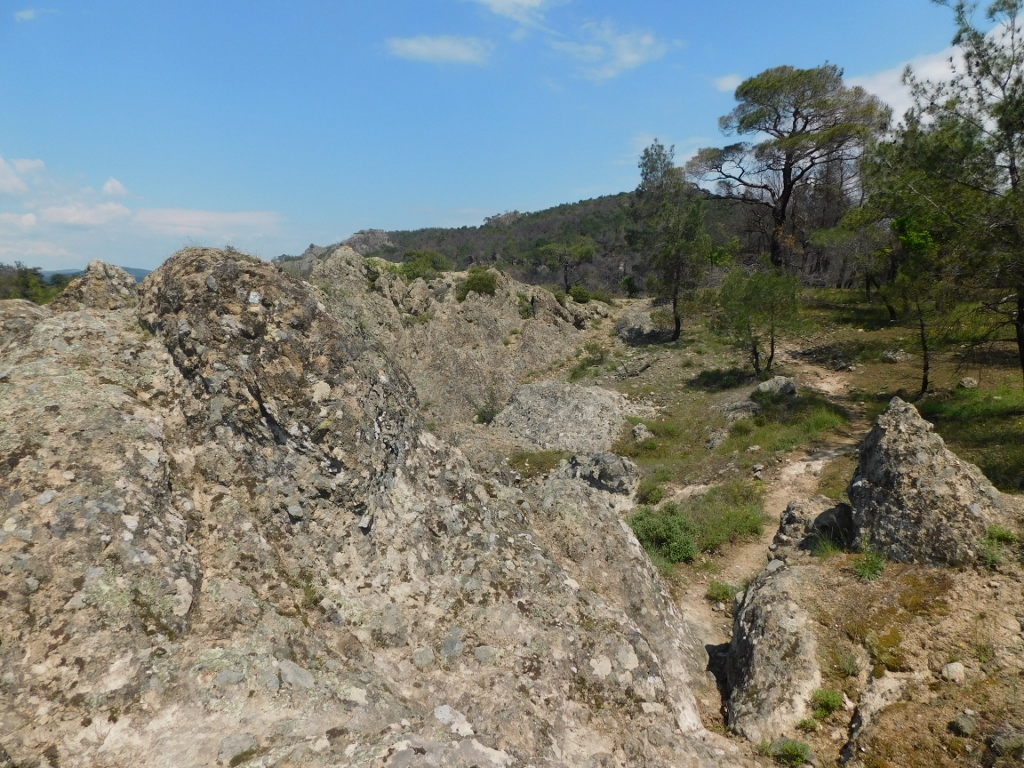 Dadia Forest at the end of April 2023
Dadia Forest at the end of April 2023
I also took advantage of a very interesting tree that grew at an exceptionally unusual angle close to the trail.
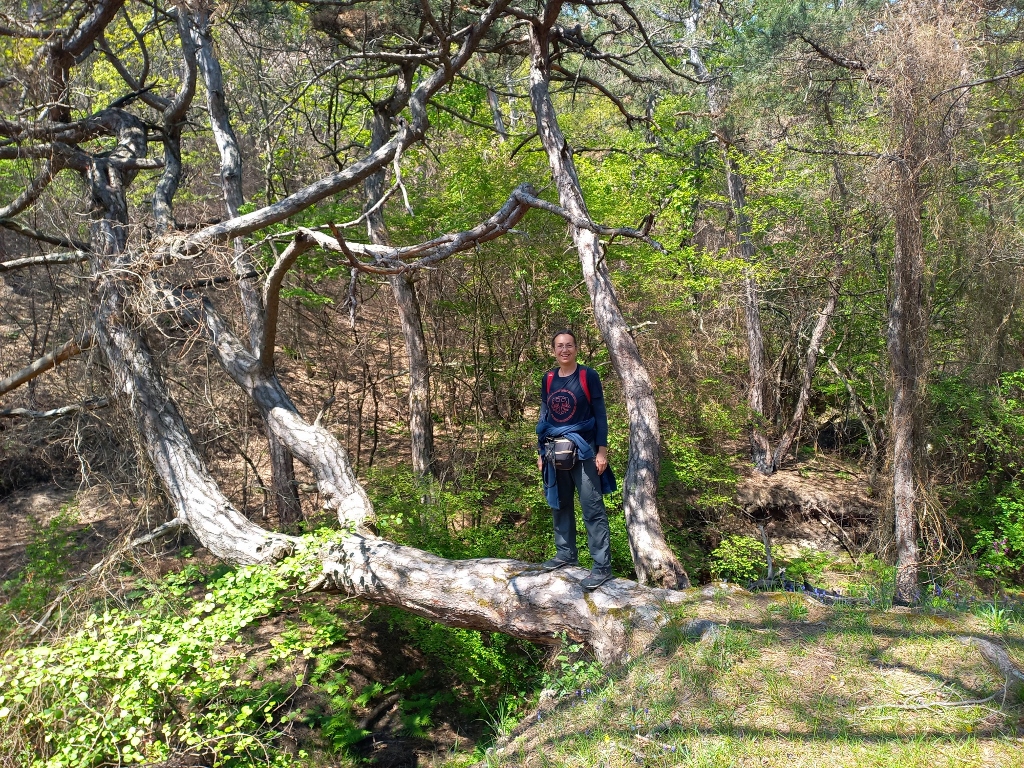 Dadia Forest at the end of April 2023
Dadia Forest at the end of April 2023
Towards the end of the hike we passed again through a section with comparatively sparse trees, while the ground was more reminiscent of a meadow.
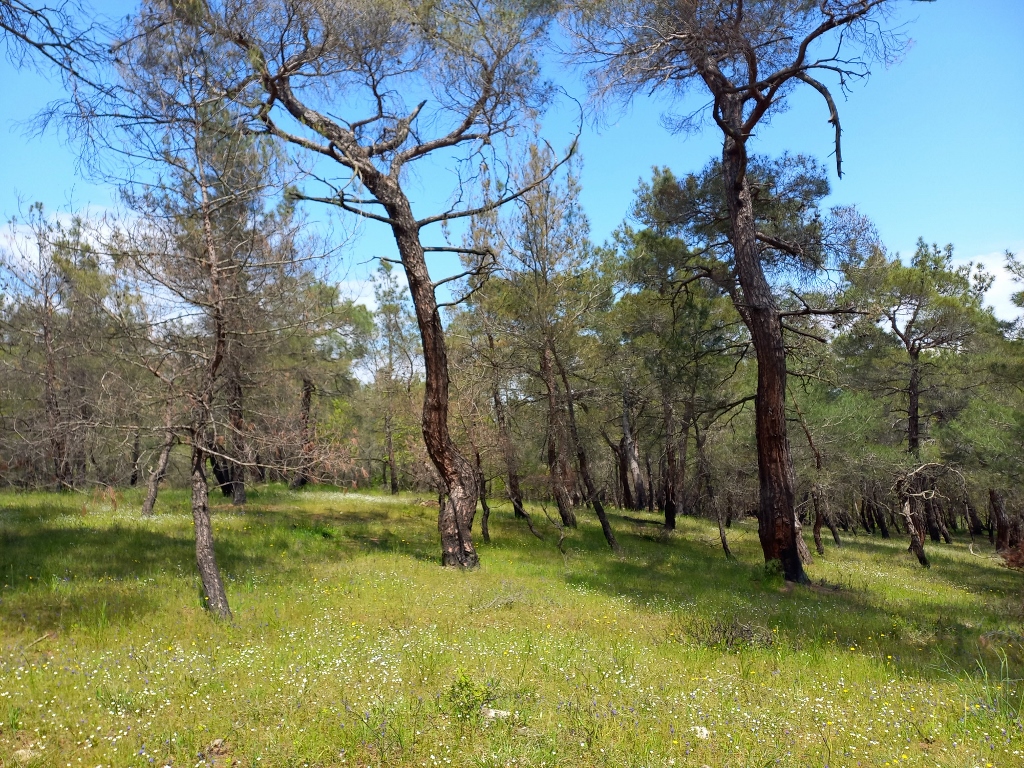 Dadia Forest at the end of April 2023
Dadia Forest at the end of April 2023
The trail also leads through some areas densely covered in ferns. One of the signs within the national park says that the ferns are a living fossil.
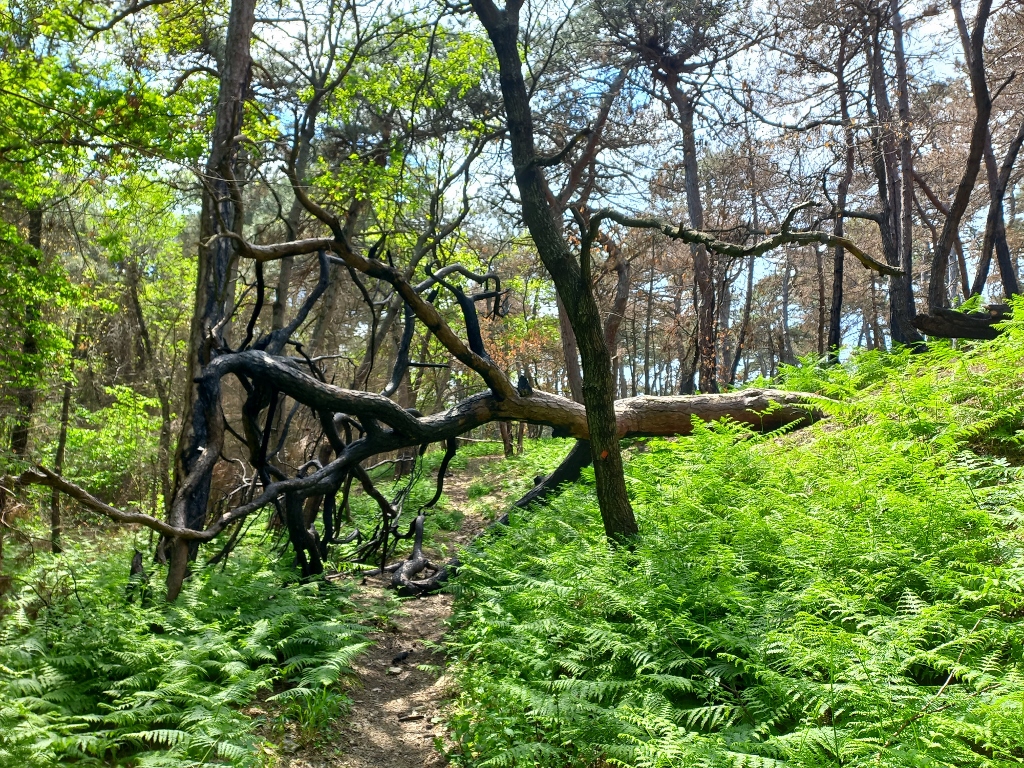 Dadia Forest at the end of April 2023
Dadia Forest at the end of April 2023
When we returned to the Dadia-Lefkimi-Soufli Forest National Park’s Visitor Centre, we all took our positions for a group photo.
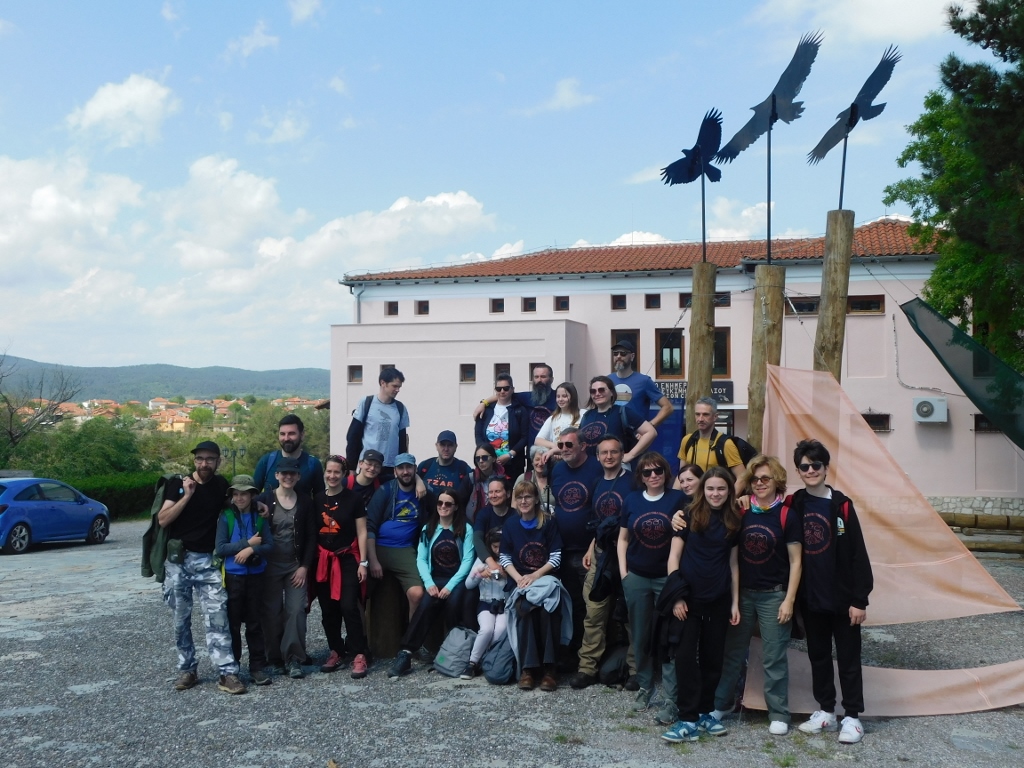 Group portrait by the Visitor Centre
Group portrait by the Visitor Centre
While we were striking the pose, a couple of black vultures flew in as if they wanted to wave us goodbye.
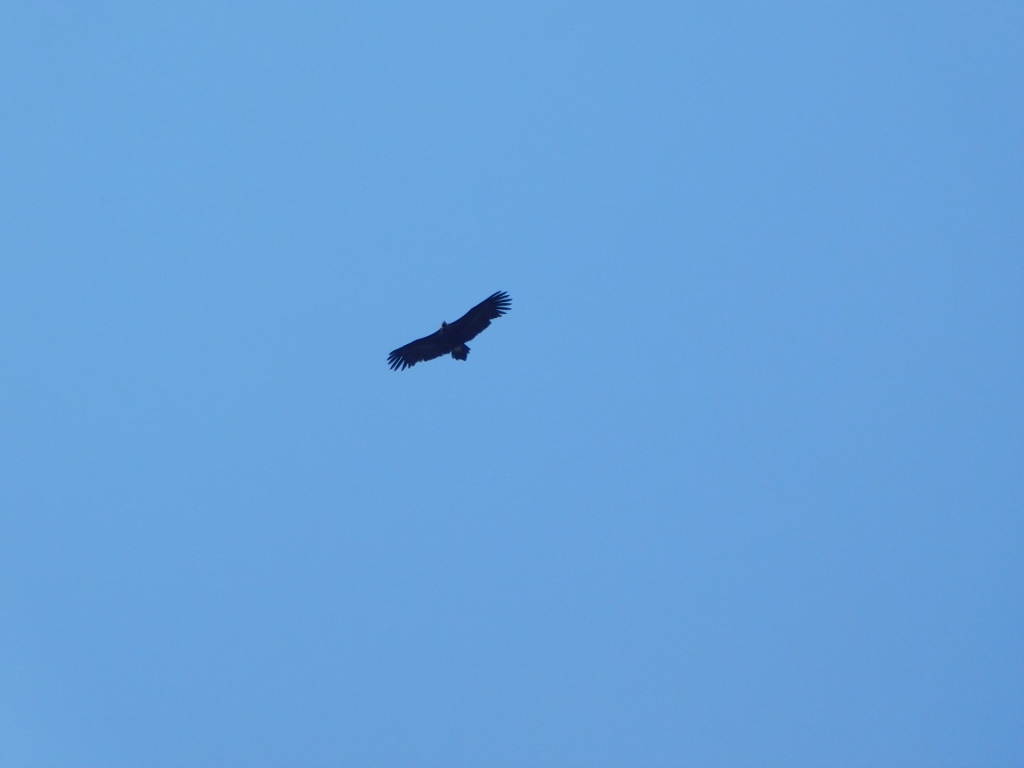 Black vulture
Black vulture